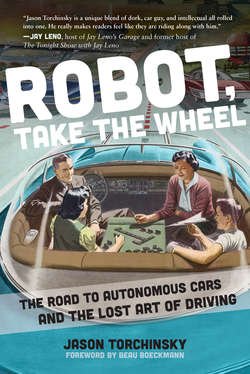Читать книгу Robot, Take the Wheel - Jason Torchinsky - Страница 13
На сайте Литреса книга снята с продажи.
1830s–1840s: Railroads
ОглавлениеThere was a pretty significant gap between when da Vinci conceived the cart and when it was produced, which isn’t really shocking, since da Vinci’s cart was never actually built and, even if it had been, as a fifteenth century Big Trak, it likely wouldn’t have had much practical use. This, however, isn’t to say that technological development in the automotive arenas wasn’t moving ahead; it was, and pretty significantly.
The advent of steam power was, of course, hugely significant in the development of the automobile. Nicolas-Joseph Cugnot had built the first full-size, working automobile in 1769, but since it was incredibly cumbersome and slow, it was doomed to wreck pretty quickly. Developments soon after led Cugnot to create increasingly practical steam-powered automobiles, with purpose-built cars like Trevithick’s London Steam Carriage of 1801. He later made others to meet the eventual boom in steam omnibuses in England in the 1830s.
But with the boom came difficulties with powerful horse lobbies that were not willing to lose business to some filthy mechanical upstarts, and this, coupled with generally poor road conditions, forced the early automobile builders to abandon the shoddy network of roads. Instead they laid a network of ideal pathways for their automobiles to traverse. These pathways were extremely low rolling resistance roads, allowing the crude vehicles to carry vast amounts of cargo and passengers; by building a set path for these automobiles, the need to develop steering systems was effectively eliminated, with the pathway handling the steering and navigation through its direction and shape.
We call these pathways “railroads” or “trains.”
In many ways, we can think of railroads as one of the earliest semiautonomous vehicle systems, and perhaps to this day still the most common and vast network. A train is an automobile, fundamentally—a self-propelled vehicle, just like the car you drive to the Dairy Queen to do your nightly burnouts in.
There are two major differences between a train and a car: scale and automation. A train is huge compared to a car. Trains, as the earliest automobiles produced in real quantities or really used by the general public, compensated for the crude state of the art by requiring fewer complex mechanisms (the locomotives) and maximizing their use by having them pull long trains of passenger and cargo cars. That’s how money was made—locomotives were not going to be the sorts of vehicles sold to every Thomas, Dickomas, or Harryomas in London.
Trains also differ from automobiles, as we understand them today, in that they have one less dimension of operator control than a car. A car’s driver can control the speed of the car via the accelerator and brake, and the direction of travel via the steering system. In trains, the operator can also control the speed via the throttle and brake, but directional control is ceded to the machine; in this case, the railroad itself, and its associated switching hardware.
In this sense a train is semiautonomous; an operator is required to control the speed and decide when to stop, but steering is autonomous. This sort of autonomy does not require any processing or understanding of the world on the part of the vehicle itself; the network the vehicle operates within handles that. A railroad is like a vast machine unto itself, with the ability to control multiple vehicles via increasingly complex switching and related hardware. These systems, in some form, were in place even by the mid-1800s.
Railroads were humanity’s first successful deployment of a semiautonomous vehicle, and it remains a staggering success.
